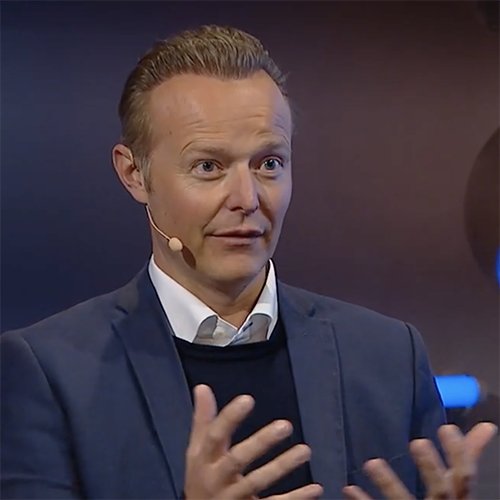The work began in autumn 2019 and was completed in the middle of the Covid pandemic during a total lockdown in Denmark. How do you succeed in delivering such a complex project, with completely new conditions and such a tight timeline? What are the challenges and lessons learned?
At this year’s Implema Inspire, Christian Houborg, VP Product Supply FUJIFILM Diosynth Biotechnologies, Preben Holst-Nielsen, Business Advisor Implement Consulting Group, and Katarina Sutrowitz, Sales Director at Implema, shared their lessons learned and experiences from the project in an interview with moderator Sabinije van Gaffke.
Selection of Business System and Partner
You made the decision in August last year to completely switch from a previous platform to SAP. What was the background to the decision to choose SAP S/4HANA and to select Implema as partner for the project?
We wanted to choose a platform for the future. A platform where we can grow into the future and develop the business. The decision we made was completely right while the project itself represented a tough challenge to go live with SAP S/4HANA within Life Science in record time, only six months, explains Christian Houborg. It has never been done before, so it was certainly a major challenge.
Houborg continues by telling about the meeting in summer 2019 in Copenhagen where FUJIFILM Diosynth Biotechnologies together with Implement Consulting Group met Implema for the first time. Implema presented the company, how they work in projects, about the Implema Way model, the budget, resources and timeline.
After an hour we asked Implema to leave the room so we could deliberate internally. As soon as they closed the door we did a high-five! Suddenly we believed that what we wanted to do was possible, explains Houborg. We had found a partner where we could work in a dynamic team, with an agile working method and within the timeframes we had already set as goals. We were impressed when Implema told us that this was a normal timeline for them. That together with Implema’s focus on teamwork made me confident in making a decision that meant we directly implemented the future platform SAP S/4HANA according to the timeline we had set up. The project was also within our budget and even a bit cheaper than what we had calculated.
Katarina Sutrowitz explains that from Implema’s side it was a “perfect match” and that Implema also did a high five when they got in the taxi back to the airport.
We had short preparation time before the meeting but felt we had the right conditions to carry out the project in a good way. We feel very confident in Implema’s way of conducting projects. Important factors for succeeding with such a project were in place: great commitment from the customer, dedication of the right resources, a desire to work together as a team, and that the customer buys into the mindset and working method that Implema follows in our projects.
Success Factors in Business System Projects
What would you say are the most important success factors in this project, not least due to the short timeline?
Industry Knowledge, Experience and Competence
Preben Holst-Nielsen begins by explaining that the right composed team of competencies is one of the most important key factors for a successful project.
By the right team and right competence I mean both the right key people from the customer’s side, but also the right consultants from the implementation partner. We primarily sought a partner with experience from S/4HANA. When we came into contact with Implema we found a partner who had done this before. Implema had experience with SAP S/4 HANA and also with new implementations / greenfield implementations. At the same time, Implema is a partner who knows our industry: pharma with requirements for validated environment. That competence and that experience is incredibly important to succeed with such a project in only six months.
Standard Processes in SAP
We were very strict in the project when it came to adhering to standards, continues Houborg. In every situation where we had a choice to stick to standard, or to develop something ourselves, we pushed for standard. Without that mindset throughout the entire organization we would never have succeeded in carrying out the project in such a short time. To ensure we would learn as much as possible we had a full 50 people from our side involved in the project. We came from another platform, and used the project as an opportunity for as many as possible to learn how to work in SAP and with the new processes.
Active Sponsorship and Quick Decisions
Active sponsorship, with management that is active and available on a daily basis to be able to make quick decisions, is yet another important success factor according to Preben Holst-Nielsen. In a classic project you can have scheduled steering committee meetings every sixth week where important decisions are expected to be made. In this project we had very active sponsorship where Christian (Houborg) was available and very active for quick decision-making. We knew the whole time which direction we should take. We had everything visualized in the project room and could quickly get management in to make quick decisions without waiting for pre-booked decision meetings. It is a very efficient way to work.
Short Timeline Facilitates Prioritization
The short timeline is important for creating focus and facilitating prioritization in the project according to Katarina Sutrowitz.
A short timeline is something we at Implema always strive for. Prioritizing becomes easy since we must prioritize standard. It sharpens your focus during the project and eliminates everything that is not necessary. Focus is on the core processes and on what is important! That is something we succeeded well with during this project I think. We collaborated and maintained focus during these six months!
Guidance and Leadership in Best Practice Processes
Adhering to standard processes may sound simple but Preben Holst-Nielsen means it also places demands.
A willingness within the company to adapt to best-practice processes is absolutely crucial. It also requires a partner with experienced and competent consultants who can lead and guide in best practice within S/4HANA. That combination is the key to successfully adhering to standards!
Stick to the Timeline
The project to implement SAP S/4HANA at FUJIFILM Diosynth Biotechnologies was driven right in the middle of a pandemic with ongoing lockdown in Denmark. Tell us how you succeeded in carrying out the project under these conditions and how you despite new, and unforeseen, conditions succeeded in sticking to the timeline?
We didn’t have much choice but stuck to the timeline, explains Houborg. The way we had set up the project meant we could carry out the project remotely without any major obstacles. The team knew each other at this point so it worked smoothly to run meetings digitally. That we succeeded in going live with only two consultants on site is a confirmation of how well the team functioned together. We were like one big team where you couldn’t feel any boundaries between the three companies. We worked hard together to ensure the implementation was successful.
Strong Vision and Team Spirit
You return to a strong team spirit. What would you say is important for creating this feeling and succeeding with such a large project in such a short time?
There are many parts to this but establishing a strong vision for the entire project where everyone understands the need for change, why it should happen in this way, and at this pace is crucial, according to Houborg. Then bringing it down to the different teams and down to the individual level so the team and individual know exactly what they need to deliver is of course important. We worked a lot with visualization and with digital collaboration tools. It is of course easier in a world without Covid where you can meet in person but it can be solved well virtually today too. You need to use a lot of time at the beginning of the project to create a common platform and to get everyone to understand “the big plan”.
End-to-End Process Organization
According to Preben Holst-Nielsen, it is important that teams have the mandate to make decisions on their own.
We organized the project with end-to-end process teams. Instead of putting a finance team in a corner to work with finance we organized the teams end-to-end according to flows and processes such as logistics, quality and warehouse. This broke down silos in the organization and got the teams to work with the entire process end-to-end.
Christian Houborg makes the connection to crowd-solving.
Everyone becomes involved in building a supply process end-to-end in the company. A recommendation to all projects out there is definitely to choose a model with an end-to-end process thinking and then stick to it strictly.
Strong Team and Project Management
What are the insights that Implema takes from this project?
The importance of strong collaboration and teamwork, says Katarina Sutrowitz. I was very impressed by how you added a new level for visualization. When you stepped into the project room it was like a war-room. Everything was visualized and prepared for quick stand-up meetings. We have also been inspired by the strong commitment all the way from top-management and through all teams and processes. That is something that has inspired us, and that we want to make even clearer in future work. It makes a big difference in really getting a tight team that collaborates together.
Project management is incredibly important according to Christian Houborg.
All three project managers in this project did a really good job. There was a common approach and collaboration throughout the entire project.
Rollout of SAP S/4hana
If you look a few years ahead. What is the next step?
Now we have efficiently gotten a site live with SAP S/4HANA. The next step is to continue rolling out SAP S/4HANA and we are working on that right now in an ongoing project together with Implement Consulting Group and Implema.
Change Management SAP S/4hana
Implementing a completely new business system is very much about change management where strong leadership forms the core. What are the most important qualities you take with you for strong leadership?
Common Vision and Ambition
Christian Houborg explains that what really made a difference was the teamwork where all three companies had a common vision, and ambition.
We wanted to break the world record in going live with SAP S/4HANA within Life Science. That gave us all the motivation to together give that little extra, to dare to test new ways of working and that the phases flowed together in an agile way of working. When you have highly set goals you can achieve fantastic things!
Team Spirit across the Entire Project
With a team spirit across the entire project, between different sites and between different companies, you really want to succeed together and achieve fantastic results. If we were to do this again we would do it again with the six-month timeline to quickly get started with the new platform and then build further on it.




